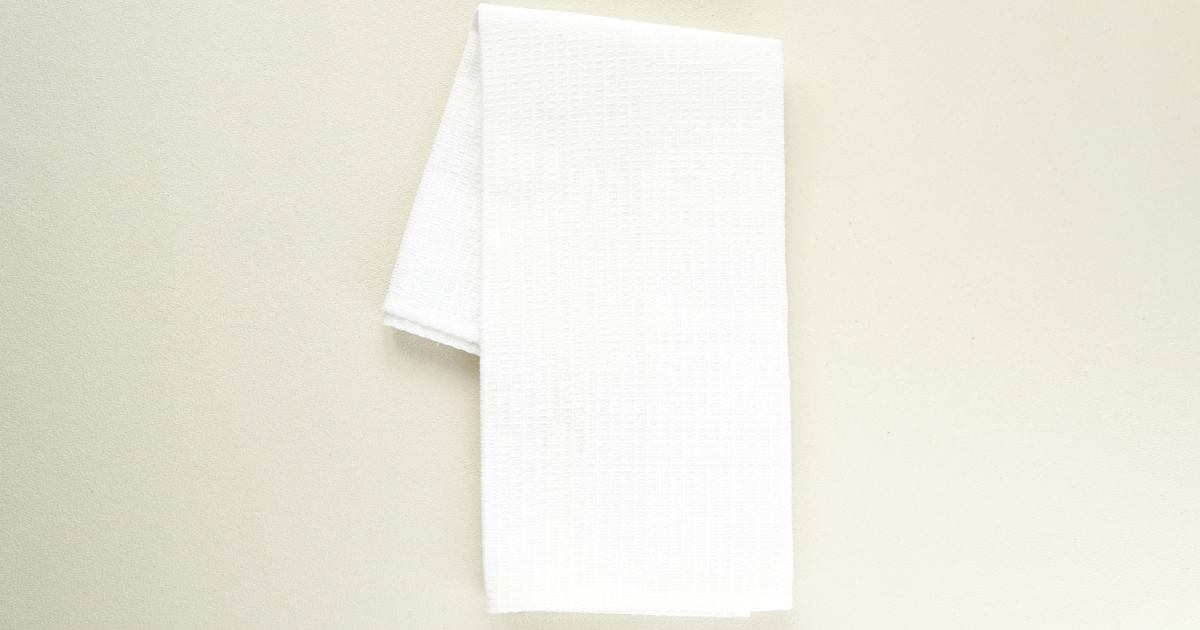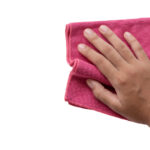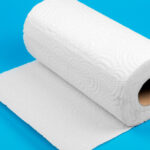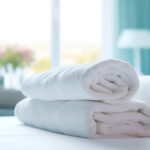Microfiber towels and waffle weave towels are both popular choices for cleaning tasks.

But what is the difference between these two types of towels? And which one is better for cleaning windows, countertops, floors and other surfaces?
What Is Microfiber?
Microfiber refers to synthetic fiber made from polyester and polyamide (nylon). The fibers are extremely fine – even finer than silk.
Here are some key features of microfiber:
- Each fiber is less than 1 denier thick – this makes the fibers very fine and thin.
- The fibers are split during production to increase surface area. This creates lots of nooks and crannies for trapping dirt and moisture.
- The shredded sides of the fibers also increase friction and absorbency.
- Microfiber has an electrostatic charge that attracts dust like a magnet before you even start cleaning.
These traits make microfiber extremely effective for cleaning and dusting. Microfiber can absorb up to 7 times its weight in liquid. And the tiny fibers grab onto dirt, grease and dust better than other fabrics.
Microfiber towels are commonly made using a knitting or weaving process. Knitted microfiber has loops that create a soft, plushy texture. Woven microfiber has a flatter, smoother surface.
What Is Waffle Weave?
Waffle weave is a type of woven microfiber fabric. It has a distinctive waffle-like pattern.
The waffle weave construction creates ridges and valleys in the fabric. This 3D structure gives waffle weave towels some unique properties:
- The raised ridges scrub dirt and grime off surfaces.
- The valleys trap and absorb liquids, grease and dirt.
- Air circulates through the waffle pattern, helping the towel dry quickly.
- The woven fabric is smooth and doesn’t snag on surfaces.
So waffle weave offers the dirt-trapping abilities of microfiber, plus extra scrubbing power and absorbency from its unique texture.
Microfiber vs Waffle Weave Towels: Key Differences
Here is a quick overview of how microfiber and waffle weave towels compare:
| Feature | Microfiber Towel | Waffle Weave Towel |
|---|---|---|
| Fiber composition | Polyester/polyamide | Polyester/polyamide |
| Construction | Knitted or woven | Woven |
| Texture | Looped, plush, soft | Flat waffle pattern |
| Absorbency | Excellent | Excellent |
| Scrubbing ability | Good | Excellent |
| Lint-free | Yes | Yes |
| Snagging | Can snag on rough surfaces | Smoother surface resists snagging |
Microfiber Towel Benefits and Uses
Microfiber towels have soft loops that make them ideal for:
- Polishing and buffing: The plush texture safely buffs surfaces without scratching. Microfiber is great for removing wax, polish and sealing products from paintwork or clear coat.
- Dusting: The fine fibers capture dust effectively. Microfiber dusters glide over surfaces and attract dust like a magnet.
- General purpose cleaning: Soft microfiber towels are versatile for all-purpose cleaning. They lift dirt from surfaces while being gentle on the finish.
- Drying vehicles: Plush microfiber towels soak up water quickly when drying your car after washing. They help leave a spot-free shine.
- Glass cleaning: The fine fibers polish glass and windows without leaving lint or streaks behind.
The main advantages of microfiber towels are their softness, absorbency and versatility. The plush texture also makes them less likely to scratch delicate surfaces.
Waffle Weave Towel Benefits and Uses
Waffle weave towels offer some additional advantages:
- Scrubbing power: The waffle texture scrubs stuck-on debris better than regular microfiber. Waffle weave excels at cleaning oily grime in kitchens and soap scum in bathrooms.
- Grease removal: The ridges dislodge grease, while the valleys trap and absorb it away from the surface.
- Soaking up spills: Waffle weave holds lots of liquid in its grid pattern. It’s great for sopping up spills and for drying.
- Cleaning rough surfaces: The woven fabric won’t snag on rough areas like stove grates.
- Faster drying: Air circulates through the waffle ridges, helping the towels dry out quicker.
- Durable: The tight woven structure makes waffle weave stronger and longer-lasting than standard microfiber.
In summary, waffle weave microfiber offers extra scrubbing power and absorbency compared to regular microfiber. It’s ideal for heavy-duty cleaning jobs where you need to break down and soak up greasy grime.
Key Takeaway: Waffle weave microfiber towels have a textured waffle pattern that provides excellent scrubbing power and absorbency for heavy-duty cleaning tasks.
When to Use Microfiber vs Waffle Weave Towels
With their different properties in mind, here are some guidelines on when to choose microfiber or waffle weave:
Use microfiber towels for:
- Polishing and buffing paintwork
- Dusting delicate surfaces
- General purpose cleaning
- Drying vehicles after washing
- Cleaning windows and glass
Use waffle weave towels for:
- Removing oily grime in kitchens
- Tackling soap scum in bathrooms
- Cleaning rough surfaces like grills
- Soaking up spills
- Heavy-duty scrubbing jobs
- Cleaning greasy machinery
Sometimes it can help to have both types on hand. For example, waffle weave can dislodge soap scum in the shower. Then a soft microfiber towel buffs the tiles dry.
Caring for Microfiber and Waffle Weave Towels
To keep your towels cleaning effectively:
- Wash new towels before first use to maximize performance.
- Wash microfiber separately from other laundry. Use a mild detergent without fabric softeners or bleach.
- Wash in hot water (140°F/60°C). High heat helps dissolve grease and oils from the towels.
- Avoid overloading the machine. Towels need room to circulate and rinse properly.
- Tumble dry on low or hang dry. High heat can damage the microfiber fibers.
- Avoid using fabric softeners and dryer sheets. They coat the fibers and reduce cleaning abilities.
With proper care, quality microfiber and waffle weave towels will provide years of use.
Microfiber vs Waffle Weave Towels: Which Cleans Better?
So which type of towel reigns supreme for cleaning tasks?
For most everyday cleaning, microfiber and waffle weave both perform excellently. Either towel will clean floors, countertops, showers and other surfaces with less effort than a conventional towel.
However, waffle weave microfiber does provide extra scrubbing power. The textured surface helps dislodge sticky, greasy messes that coat and clog regular microfiber towels.
So if you need to tackle heavily soiled areas like ovens, grills and machinery, reach for a waffle weave towel. The scrubbing ridges will power through baked-on grime that microfiber alone can’t handle.
For gentle, routine cleaning, microfiber and waffle weave are equally good options. Let the job at hand and type of soiling guide your choice.
Having both towels in your cleaning toolkit gives you flexibility to pick the right tool for each task.
Key Differences Between Microfiber and Waffle Weave Towels
To recap, here are the main differences between microfiber and waffle weave cleaning towels:
| Microfiber | Waffle Weave | |
|---|---|---|
| Texture | Looped, plush | Flat waffle pattern |
| Strengths | Versatile, polishes well, gentle | Scrubs stuck-on grime, absorbs grease |
| Best for | Polishing, drying, dusting, glass | Grease, soap scum, rough surfaces |
| Durability | Good | Excellent |
FAQs
Are microfiber or waffle weave towels better for windows?
Either towel will clean windows well. Microfiber won’t leave lint. Waffle weave excels at absorbing any moisture left behind.
Can you use waffle weave on paintwork?
Yes, but a plush microfiber towel is gentler for polished paint. Only use waffle weave if you need extra scrubbing power to remove bonded contaminants. Always use light pressure.
Is waffle weave scratchy?
No, waffle weave is woven so it has a smooth surface. It is safe for all hard surfaces and won’t scratch.
Can you put microfiber towels in the dryer?
Yes, tumble dry on low heat. High temperatures may damage the fibers over time.
How do you wash waffle weave towels?
Wash in hot water with a mild detergent. Avoid fabric softeners. Tumble dry low or hang dry.
Why does my microfiber towel leave lint?
Excess lint means the towel is wearing out. Lint can also come from washing with cotton fabrics. Replace old towels.
How long do microfiber towels last?
With proper care, quality microfiber towels will last through at least 100 wash cycles. Waffle weave may last longer thanks to its durable woven structure.
Conclusion
Microfiber and waffle weave towels both make cleaning faster and easier compared to conventional materials like cotton.
Choose plush microfiber towels for gentle, routine cleaning and polishing tasks. Use waffle weave when you need extra scrubbing power for stuck-on grease and grime.
Maintain your towels by washing in hot water without fabric softeners. With proper care, microfiber and waffle weave towels will provide years of superb cleaning performance.







